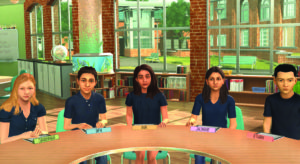Alastair Fielden, Connect’s education consultant discusses how our virtual reality platform C-Live can be used to develop life skills for pupils.

For many young people, whether or not they have SEND, the prospect of moving into work and finding a role for themselves beyond the walls of education is a daunting if not, for some, frightening prospect with many unknowns. One of the key aims in the 0-25 SEND Code of Practice is to help young people prepare for adulthood so that, as far as possible, they have gained knowledge, skills and confidence to enter the next stage on their journey.
Confidence, it could be argued, plays a very large part in how successfully we are able to take on new challenges in learning or work situations. From personal presentation skills to knowing how to conduct ourselves at interviews and dealing with co-workers, young people need practice with these areas as part of their readiness for work and adult life.
Being able to teach and develop these kinds of interpersonal skills in a way that supports learners with SEND is a key focus for schools as students come up to the end of their secondary and post-16 education. Students who lack confidence, are nervous, or who have higher levels of anxiety, will need supportive strategies and a structure that enables them to practise their communication and interpersonal skills. Some students are not yet confident enough with live practice situations, nor with being filmed and watching the feedback to analyse their ‘performance’.
Within school, mock interviews and presentations are a useful way to help students practise these kinds of skills. However, because the students are often interacting with their teachers and peers, the situations may feel a little contrived. Students can also feel self-conscious and some may find it more difficult to relate to peers and staff playing the part of a job interviewer.
What if there were a resource that could assist students in overcoming their confidence issues and anxiety by making the exercise more realistic for them, yet provide schools and colleges with an interactive training resource? Such a resource could be flexible enough to use as a stand-alone activity, as well as being able to integrate with the school’s existing programme. It could then be also used as an effective tool to enhance the transition process for the students.

What may be of interest to schools is Connect’s new C-Live tool. This uses a blend of technology with human interaction in real-time scenarios. The participants see a computer-generated avatar on the screen and practise a given scenario, such as a job interview with the character on the screen. What makes this technology distinct from other computer-generated software is the human element. A trained inter-actor controls the avatar so that real-time responses are given back to the participant which dynamically changes the situation, simulating a real interview. Schools can specify the kind of scenario they wish their students to practise. If the student loses their train of thought, they can pause the simulation to begin again, or if there is a particular part of the scenario they need to work on, they can focus on this.
This kind of Technology for training is also being used by corporate firms to train employees in aspects of customer service, and by medical professionals, so that they can perfect their skills without affecting their actual service users. Find out more here.